The Anisotropic Electrothermal Behavior and Deicing Performance of a Self-Healing Epoxy Composite Reinforced with Glass/Carbon Hybrid Fabrics
Abstract
1. Introduction
2. Results and Discussion
2.1. Mechanical Property Analysis
2.2. Electrically Heated Behavior
2.3. Deicing Performance
2.4. Micro-Structural Analysis
3. Materials and Methods
3.1. Preparation of Glass Fiber/Carbon Fiber Epoxy Resin Composites
3.2. Test Instrument and Method
4. Conclusions
Author Contributions
Funding
Institutional Review Board Statement
Informed Consent Statement
Data Availability Statement
Acknowledgments
Conflicts of Interest
References
- Monticeli, F.M.; Almeida, J.H.S., Jr.; Neves, R.M.; Ornaghi, F.G.; Ornaghi, H.L. On the 3D void formation of hybrid carbon/glass fiber composite laminates: A statistical approach. Compos. Part A Appl. Sci. Manuf. 2020, 137, 106036. [Google Scholar] [CrossRef]
- Guermazi, N.; Haddar, N.; Elleuch, K.; Ayedi, H.F. Investigations on the fabrication and the characterization of glass/epoxy, carbon/epoxy and hybrid composites used in the reinforcement and the repair of aeronautic structures. Mater. Des. (1980–2015) 2014, 56, 714–724. [Google Scholar] [CrossRef]
- Chen, X.; Chen, T.; Huang, M.; Du, X. Improving the fracture toughness, electrical conductivity and electro-thermal performance of hybrid glass/carbon fiber reinforced epoxy composites with surface-sulfonated polypropylene fabrics. Polym. Compos. 2024, 45, 11022–11032. [Google Scholar] [CrossRef]
- Ray, B.C. Temperature effect during humid ageing on interfaces of glass and carbon fibers reinforced epoxy composites. J. Colloid Interface Sci. 2006, 298, 111–117. [Google Scholar] [CrossRef] [PubMed]
- Ducept, F.; Davies, P.; Gamby, D. An experimental study to validate tests used to determine mixed mode failure criteria of glass/epoxy composites. Compos. Part A Appl. Sci. Manuf. 1997, 28, 719–729. [Google Scholar] [CrossRef]
- Gupta, K. Mechanical and abrasive wear characterization of bidirectional and chopped E-glass fiber reinforced composite materials. Mater. Des. 2012, 35, 467–479. [Google Scholar]
- Vertuccio, L.; De Santis, F.; Pantani, R.; Lafdi, K.; Guadagno, L. Effective de-icing skin using graphene-based flexible heater. Compos. Part B Eng. 2019, 162, 600–610. [Google Scholar] [CrossRef]
- Xu, F.; Du, X.-S.; Liu, H.-Y.; Guo, W.-G.; Mai, Y.-W. Temperature effect on nano-rubber toughening in epoxy and epoxy/carbon fiber laminated composites. Compos. Part B Eng. 2016, 95, 423–432. [Google Scholar] [CrossRef]
- Dehghani-Sanij, A.R.; Dehghani, S.R.; Naterer, G.F.; Muzychka, Y. Sea spray icing phenomena on marine vessels and offshore structures: Review and formulation. Ocean Eng. 2017, 132, 25–39. [Google Scholar] [CrossRef]
- Madi, E.; Pope, K.; Huang, W.; Iqbal, T. A review of integrating ice detection and mitigation for wind turbine blades. Renew. Sustain. Energy Rev. 2019, 103, 269–281. [Google Scholar] [CrossRef]
- Zheng, M.; Guo, Z.; Dong, W.; Guo, X. Experimental investigation on ice accretion on a rotating aero-engine spinner with hydrophobic coating. Int. J. Heat Mass Transf. 2019, 136, 404–414. [Google Scholar] [CrossRef]
- Wang, T.; Zheng, Y.; Raji, A.-R.O.; Li, Y.; Sikkema, W.K.; Tour, J.M. Passive Anti-Icing and Active Deicing Films. ACS Appl. Mater. Interfaces 2016, 8, 14169–14173. [Google Scholar] [CrossRef] [PubMed]
- Jamil, M.I.; Ali, A.; Haq, F.; Zhang, Q.; Zhan, X.; Chen, F. Icephobic Strategies and Materials with Superwettability: Design Principles and Mechanism. Langmuir 2018, 34, 15425–15444. [Google Scholar] [CrossRef] [PubMed]
- Hong, X.; Dai, M.; Ke, C.; Wang, G.; Qian, C.; Zhu, C. Graphite oxide/reduced graphite oxide surface modified carbon fiber reinforced composites for deicing and electromagnetic interference shielding. J. Mater. Sci. Mater. Electron. 2023, 34, 77. [Google Scholar] [CrossRef]
- Zhu, R.; Li, X.; Wu, C.; Du, L.; Du, X. The In-Situ Mechanical Properties of Carbon Fiber/Epoxy Composite under the Electric-Current Loading. Polymers 2022, 14, 4452. [Google Scholar] [CrossRef]
- Mandal, S.; Samanta, K.; Debnath, T.; Kumar, S.; Bose, S. Graphene Oxide Pre-Installed with a Covalent Adaptable Network Resulted in a “Nacre-Like” and “Self-Healable” Multi-Layered Interface in Carbon Fiber Laminates. Small Methods 2025. [Google Scholar] [CrossRef]
- Tarfaoui, M.; El Moumen, A.; Boehle, M.; Shah, O.; Lafdi, K. Self-heating and deicing epoxy/glass fiber based carbon nanotubes buckypaper composite. J. Mater. Sci. 2018, 54, 1351–1362. [Google Scholar] [CrossRef]
- Park, J.; Jeong, Y.G. Investigation of microstructure and electric heating behavior of hybrid polymer composite films based on thermally stable polybenzimidazole and multiwalled carbon nanotube. Polymer 2015, 59, 102–109. [Google Scholar] [CrossRef]
- Liu, Y.; Xiao, Z.; Zhang, W.; Huang, H.; Zhang, J.; Gan, Y.; He, X.; Wang, B.; Han, Y.; Xia, Y. Glass fiber reinforced graphite/carbon black@PES composite films for high-temperature electric heaters. J. Ind. Eng. Chem. 2022, 107, 401–409. [Google Scholar] [CrossRef]
- Swolfs, Y.; Gorbatikh, L.; Verpoest, I. Fibre hybridisation in polymer composites: A review. Compos. Part A Appl. Sci. Manuf. 2014, 67, 181–200. [Google Scholar] [CrossRef]
- Fu, X.; Wan, G.; Guo, H.; Kim, H.J.; Yang, Z.; Tan, Y.J.; Ho, J.S.; Tee, B.C. Self-healing actuatable electroluminescent fibres. Nat. Commun. 2024, 15, 10498. [Google Scholar] [CrossRef] [PubMed]
- Jiang, Q.; Wan, Y.; Qin, Y.; Qu, X.; Zhou, M.; Huo, S.; Wang, X.; Yu, Z.; He, H. Durable and wearable self-powered temperature sensor based on self-healing thermoelectric fiber by coaxial wet spinning strategy for fire safety of firefighting clothing. Adv. Fiber Mater. 2024, 6, 1387–1401. [Google Scholar] [CrossRef]
- Xue, R.; Zhao, H.; An, Z.W.; Wu, W.; Jiang, Y.; Li, P.; Huang, C.X.; Shi, D.; Li, R.K.Y.; Hu, G.H.; et al. Self-Healable, Solvent Response Cellulose Nanocrystal/Waterborne Polyurethane Nanocomposites with Encryption Capability. ACS Nano 2023, 17, 5653–5662. [Google Scholar] [CrossRef] [PubMed]
- Wang, B.; Li, Z.; Liu, X.; Li, L.; Yu, J.; Li, S.; Guo, G.; Gao, D.; Dai, Y. Preparation of Epoxy Resin with Disulfide-Containing Curing Agent and Its Application in Self-Healing Coating. Materials 2023, 16, 4440. [Google Scholar] [CrossRef]
- Lee, M.K.; Kim, M.O.; Lee, T.; Cho, S.; Kim, D.; Chang, W.; Kwon, Y.; Lee, S.M.; Kim, J.K.; Son, B.C. Epoxy-Based Vitrimers for Sustainable Infrastructure: Emphasizing Recycling and Self-Healing Properties. Polymers 2025, 17, 373. [Google Scholar] [CrossRef]
- Zhang, Y.; Zhang, S.; Zhai, M.; Wei, B.; Lyu, B.; Liu, L. Self-Healing and Recyclable Castor Oil-Based Epoxy Vitrimer Based on Dual Dynamic Bonds of Disulfide and Ester Bonds. ACS Appl. Polym. Mater. 2024, 6, 8399–8408. [Google Scholar] [CrossRef]
- Liu, C.; Xie, W.; Hao, Y.; Chen, Z.; Wang, T.; Ma, R.; Han, L.; Liu, R.; Sun, Z. Liquid-like hyperbranched epoxy resin slippery coating with durable self-healing property by dynamic disulfide bonds. Prog. Org. Coat. 2025, 200, 109039. [Google Scholar] [CrossRef]
- Li, W.; Xiao, L.; Wang, Y.; Chen, J.; Nie, X. Self-healing silicon-containing eugenol-based epoxy resin based on disulfide bond exchange: Synthesis and structure-property relationships. Polymer 2021, 229, 123967. [Google Scholar] [CrossRef]
- Zhang, B.; Fan, H.; Xu, W.; Duan, J. Thermally triggered self-healing epoxy coating towards sustained anti-corrosion. J. Mater. Res. Technol. 2022, 17, 2684–2689. [Google Scholar] [CrossRef]
- Krishnakumar, B.; Sanka, R.V.S.P.; Binder, W.H.; Park, C.; Jung, J.; Parthasarthy, V.; Rana, S.; Yun, G.J. Catalyst free self-healable vitrimer/graphene oxide nanocomposites. Compos. Part B Eng. 2020, 184, 107647. [Google Scholar] [CrossRef]
- Kabir, M.M.; Mustak, R.; Sadik, M.M.H. Effect of bio-filler on various properties of glass fiber reinforced epoxy composites. Hybrid Adv. 2025, 10, 100448. [Google Scholar] [CrossRef]
- Xia, G.; Lu, Y.; Gao, X.; Gao, C.; Xu, H. Electro-Fenton Degradation of Methylene Blue Using Polyacrylonitrile-Based Carbon Fiber Brush Cathode. CLEAN–Soil Air Water 2014, 43, 229–236. [Google Scholar] [CrossRef]
- Wang, F.X.; Liang, W.Y.; Wang, Z.Q.; Yang, B.; He, L.; Zhang, K. Preparation and property investigation of multi-walled carbon nanotube (MWCNT)/epoxy composite films as high-performance electric heating (resistive heating) element. Express Polym. Lett. 2018, 12, 285–295. [Google Scholar] [CrossRef]
- Ohnabe, H.; El-Tantawy, F.; Kamada, K. In situ network structure, electrical and thermal properties of conductive epoxy resin–carbon black composites for electrical heater applications. Mater. Lett. 2002, 56, 112–126. [Google Scholar]
- Yan, J.; Jeong, Y.G. Synergistic effect of hybrid carbon fillers on electric heating behavior of flexible polydimethylsiloxane-based composite films. Compos. Sci. Technol. 2015, 106, 134–140. [Google Scholar] [CrossRef]
- Wang, Y.; Jiang, H.; Tao, Y.; Mei, T.; Liu, Q.; Liu, K.; Li, M.; Wang, W.; Wang, D. Polypyrrole/poly(vinyl alcohol-co-ethylene) nanofiber composites on polyethylene terephthalate substrate as flexible electric heating elements. Compos. Part A Appl. Sci. Manuf. 2016, 81, 234–242. [Google Scholar] [CrossRef]
- Wu, W.; Huang, X.; Li, K.; Yao, R.; Chen, R.; Zou, R. A functional form-stable phase change composite with high efficiency electro-to-thermal energy conversion. Appl. Energy 2017, 190, 474–480. [Google Scholar] [CrossRef]
- Zhou, Y.; Wang, X.; Liu, X.; Sheng, D.; Ji, F.; Dong, L.; Xu, S.; Wu, H.; Yang, Y. Polyurethane-based solid-solid phase change materials with halloysite nanotubes-hybrid graphene aerogels for efficient light- and electro-thermal conversion and storage. Carbon 2019, 142, 558–566. [Google Scholar] [CrossRef]
- Pan, L.; Liu, Z.; Kiziltaş, O.; Zhong, L.; Pang, X.; Wang, F.; Zhu, Y.; Ma, W.; Lv, Y. Carbon fiber/poly ether ether ketone composites modified with graphene for electro-thermal deicing applications. Compos. Sci. Technol. 2020, 192, 108117. [Google Scholar] [CrossRef]
- Wang, B.; Feng, X.; Liu, L. Enhanced electrothermal effect of carbon fibrous composites decorated with high conductive carbon nanotube webs. Chin. J. Aeronaut. 2021, 34, 243–253. [Google Scholar] [CrossRef]
- Lai, Y.; Kuang, X.; Zhu, P.; Huang, M.; Dong, X.; Wang, D. Colorless, transparent, robust, and fast scratch-self-healing elastomers via a phase-locked dynamic bonds design. Adv. Mater. 2018, 30, 1802556. [Google Scholar] [CrossRef] [PubMed]
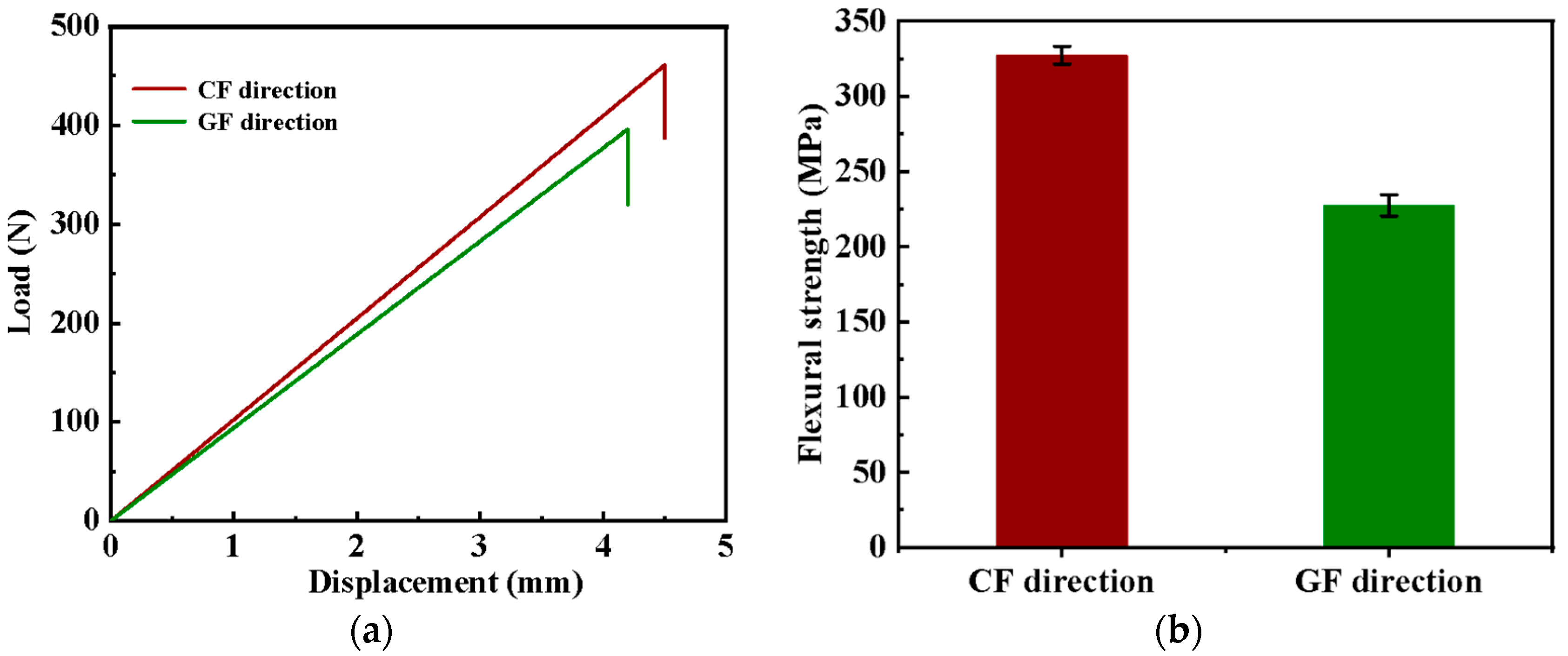

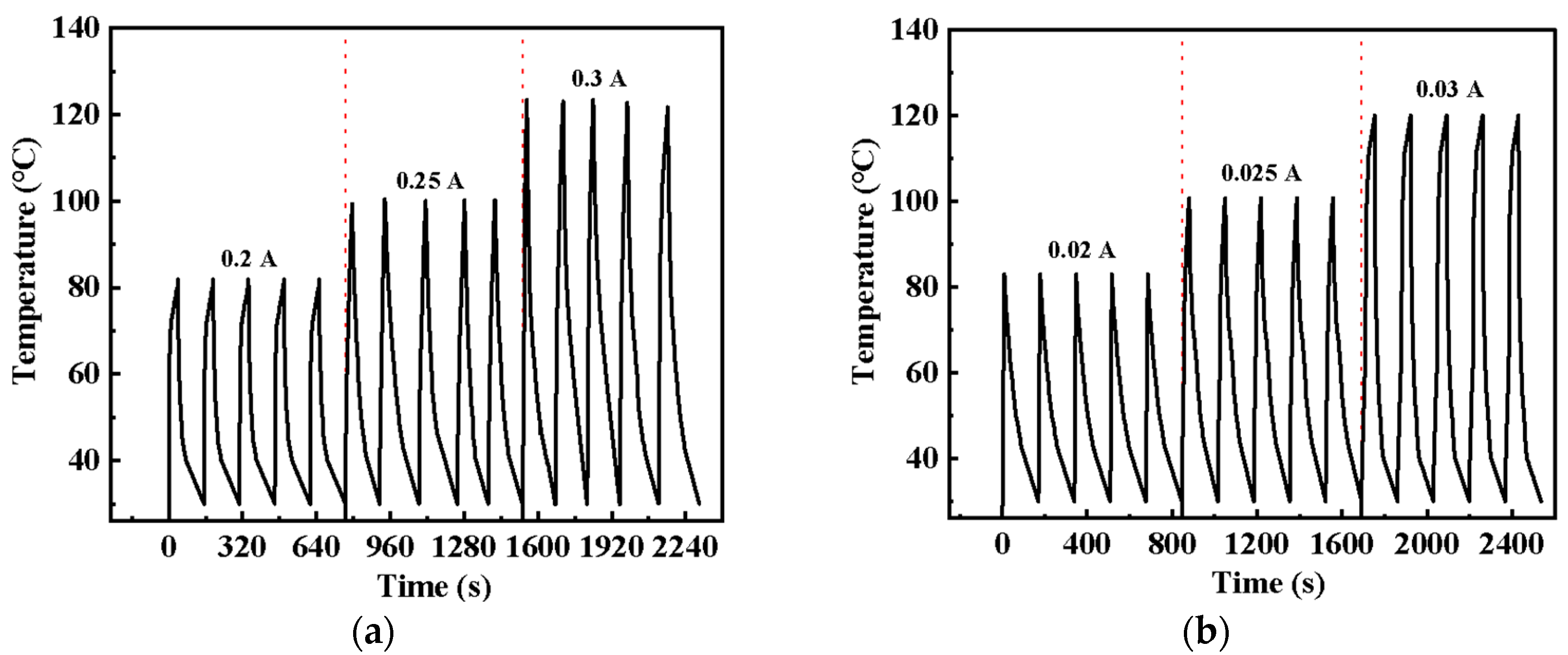
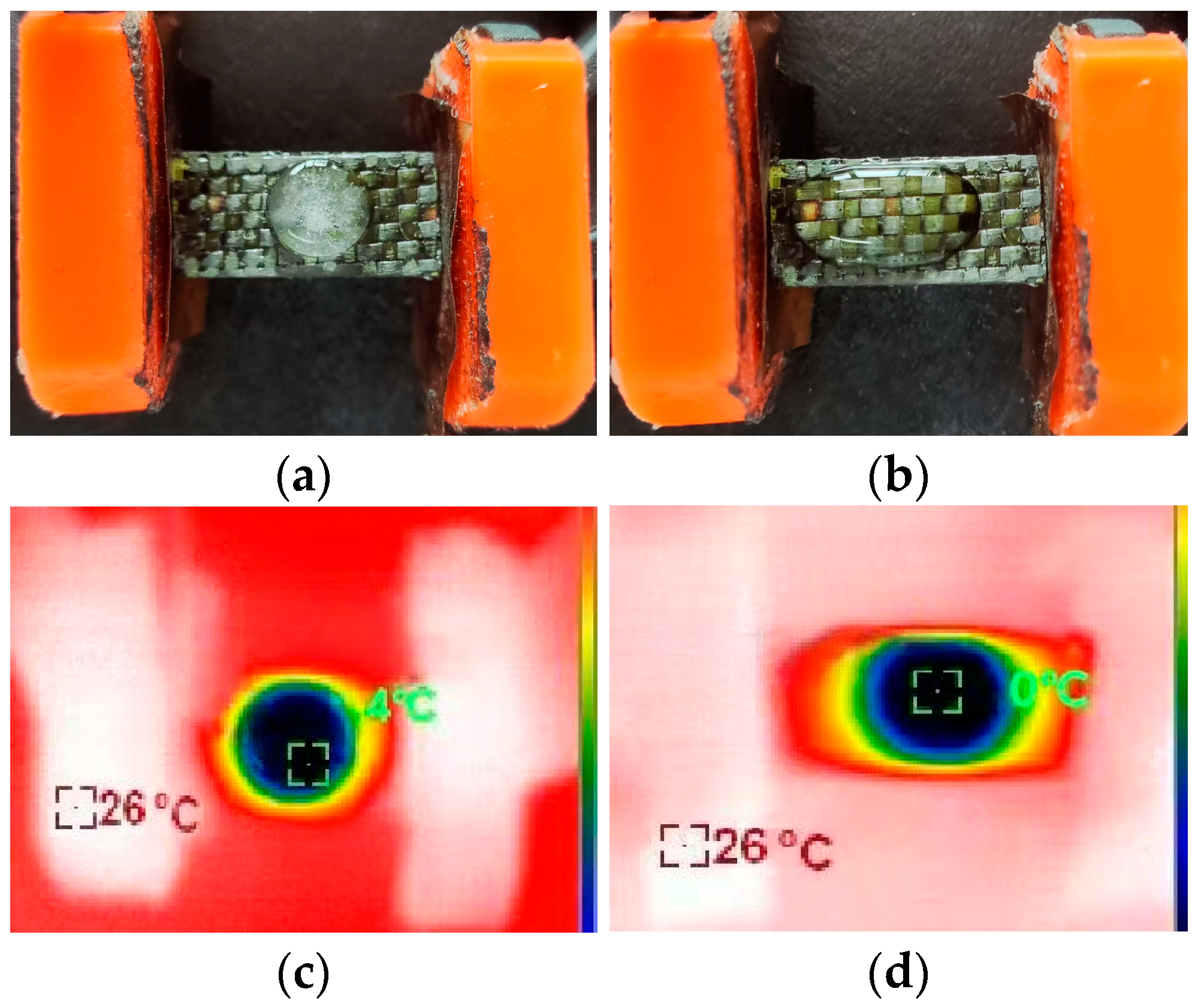
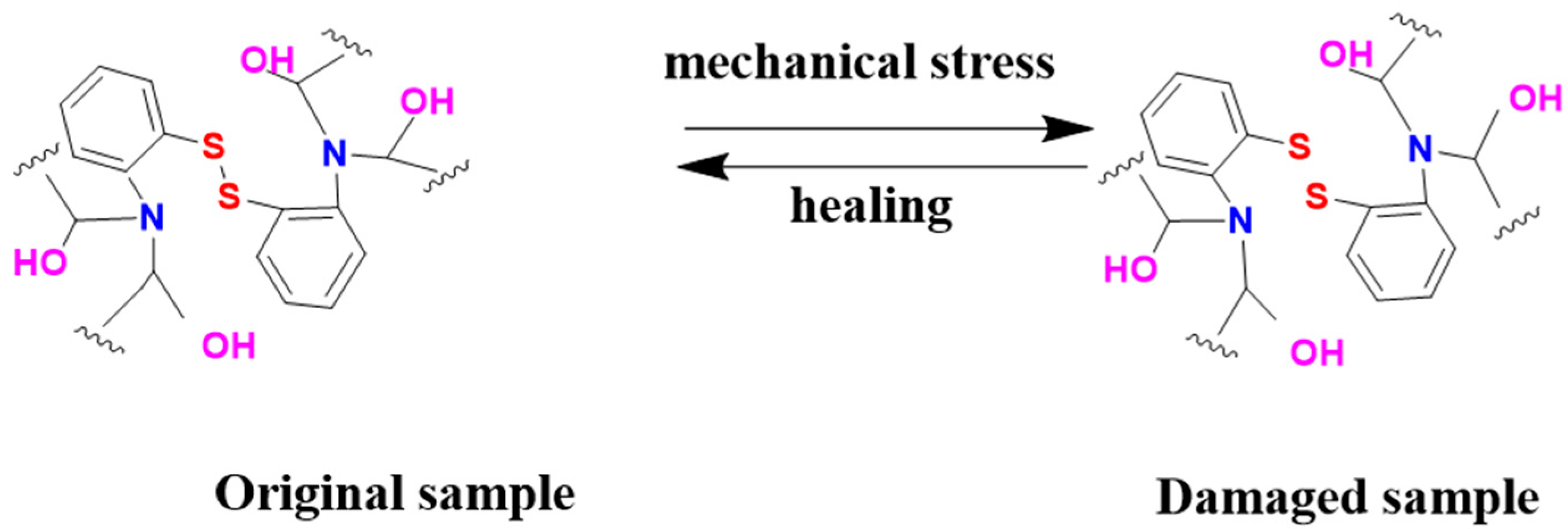
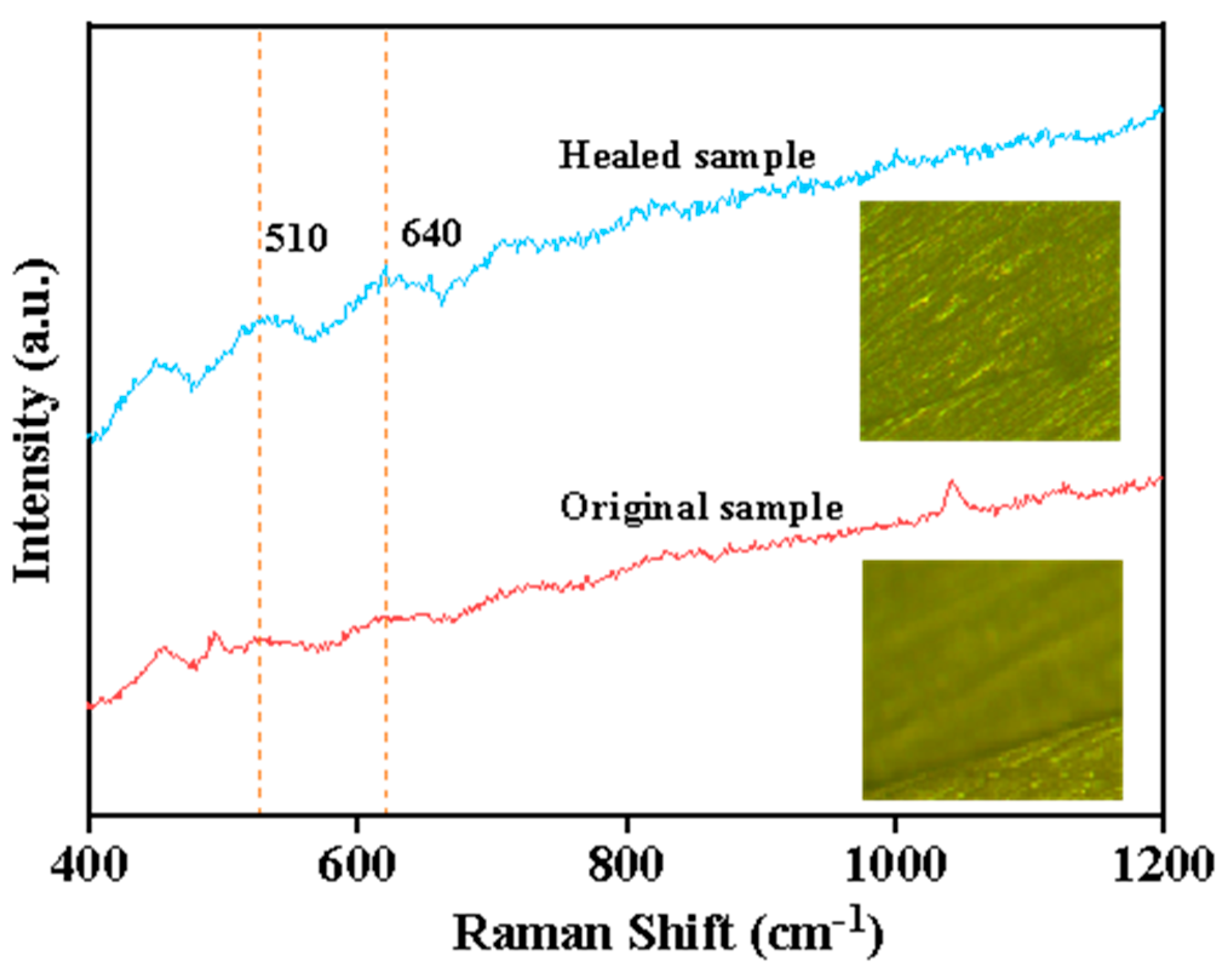

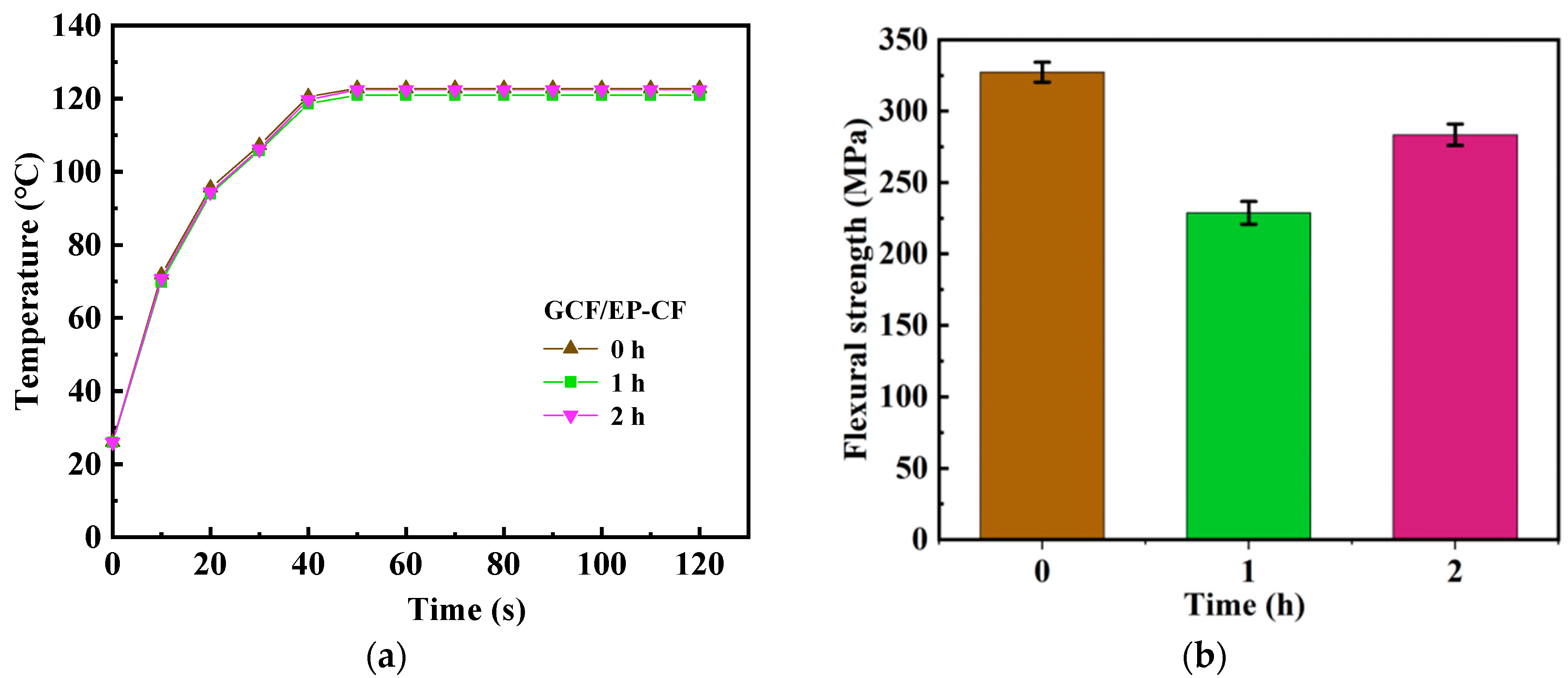
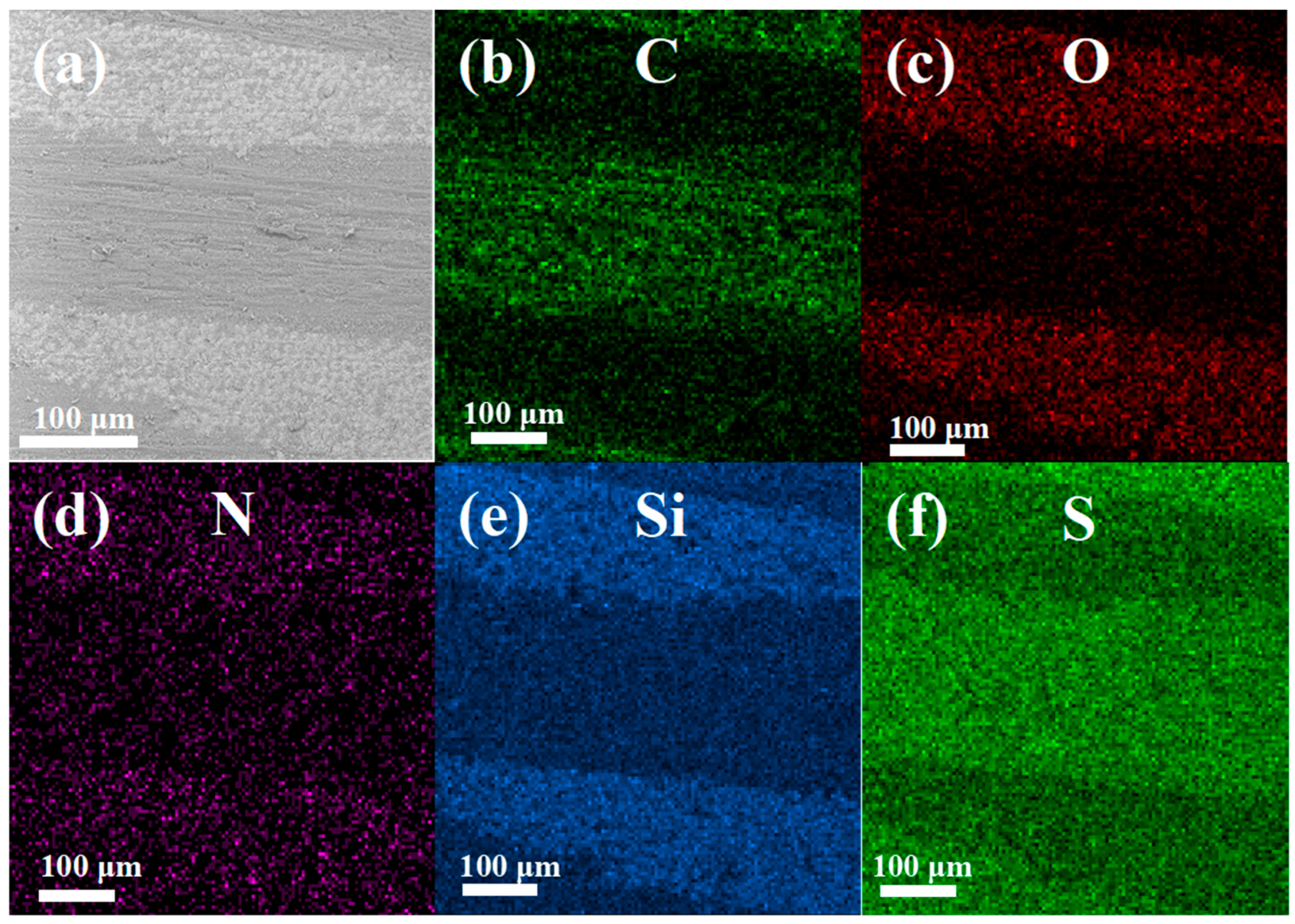


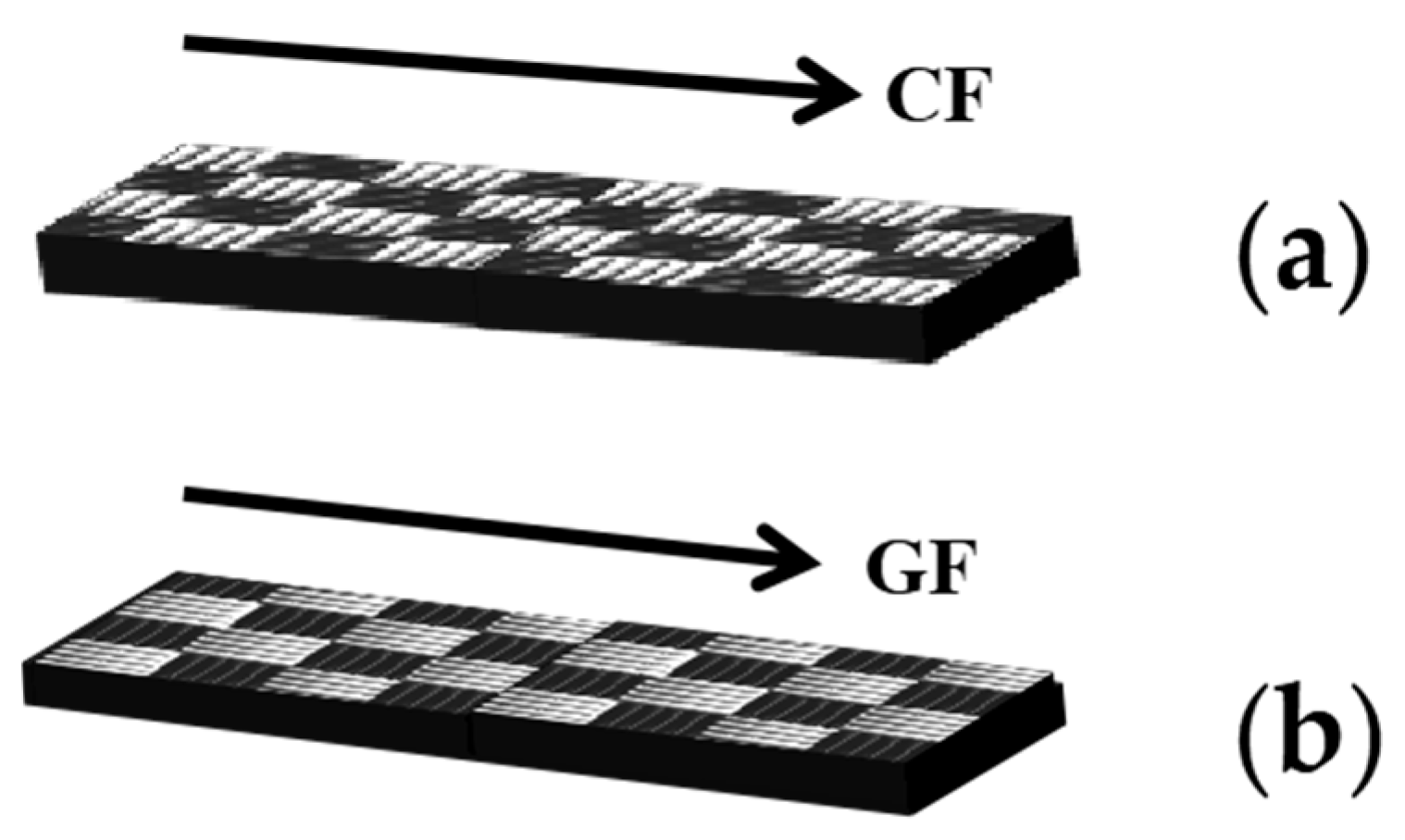
| Sample | Applied Current (A) | Equilibrium Temperature (°C) | τg (s) |
|---|---|---|---|
| GCF/EP-CF | 0.2 | 81.9 | 12.19 ± 3.83 |
| 0.25 | 100.4 | 12.20 ± 1.55 | |
| 0.3 | 122.8 | 16.03 ± 0.40 | |
| GCF/EP-GF | 0.02 | 81.5 | 18.65 ± 2.31 |
| 0.025 | 100.8 | 20.62 ± 1.93 | |
| 0.03 | 120.1 | 21.77 ± 3.87 |
| Sample | I (A) | U (v) | tdeice (s) | ηdeice (%) |
|---|---|---|---|---|
| GCF/EP-CF | 0.2 | 6.89 | 132 | 77.36 |
| 0.25 | 5.93 | 120 | 79.10 | |
| 0.3 | 5.30 | 107 | 82.71 | |
| GCF/EP-GF | 0.02 | 54.80 | 203 | 63.25 |
| 0.025 | 44.29 | 190 | 66.89 | |
| 0.03 | 44.37 | 153 | 69.55 |
| Sample | Resistance (Ω) | Flexural Strength (MPa) | ηdeice (%) |
|---|---|---|---|
| GCF/EP-CF | 21.4 | 327.3 | 82.71 |
| GCF/EP-CF1 | 23.2 | 283.5 | 81.37 |
Disclaimer/Publisher’s Note: The statements, opinions and data contained in all publications are solely those of the individual author(s) and contributor(s) and not of MDPI and/or the editor(s). MDPI and/or the editor(s) disclaim responsibility for any injury to people or property resulting from any ideas, methods, instructions or products referred to in the content. |
© 2025 by the authors. Licensee MDPI, Basel, Switzerland. This article is an open access article distributed under the terms and conditions of the Creative Commons Attribution (CC BY) license (https://creativecommons.org/licenses/by/4.0/).
Share and Cite
Chen, T.; Du, X. The Anisotropic Electrothermal Behavior and Deicing Performance of a Self-Healing Epoxy Composite Reinforced with Glass/Carbon Hybrid Fabrics. Molecules 2025, 30, 2794. https://doi.org/10.3390/molecules30132794
Chen T, Du X. The Anisotropic Electrothermal Behavior and Deicing Performance of a Self-Healing Epoxy Composite Reinforced with Glass/Carbon Hybrid Fabrics. Molecules. 2025; 30(13):2794. https://doi.org/10.3390/molecules30132794
Chicago/Turabian StyleChen, Ting, and Xusheng Du. 2025. "The Anisotropic Electrothermal Behavior and Deicing Performance of a Self-Healing Epoxy Composite Reinforced with Glass/Carbon Hybrid Fabrics" Molecules 30, no. 13: 2794. https://doi.org/10.3390/molecules30132794
APA StyleChen, T., & Du, X. (2025). The Anisotropic Electrothermal Behavior and Deicing Performance of a Self-Healing Epoxy Composite Reinforced with Glass/Carbon Hybrid Fabrics. Molecules, 30(13), 2794. https://doi.org/10.3390/molecules30132794






